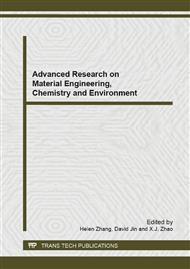[1]
G. Muhammad-Barzani, B.S. Ismail, Sahibin Abd Rahim, Sujaul-Islam Mir and C.C. Tan: Hydrology and Water Quality Assessment of the Tasik Chini's Feeder Rivers, Pahang, Malaysia. American-Eurasian J. Agric. & Environ. Sci. vol. 2 , No. 1(2007).
Google Scholar
[2]
Jacobs H: Water quality criteria. Journal of Water Pollution Control Federation, Vol. 37, No. 5(1965), pp.292-300.
Google Scholar
[3]
Lumb A, Halliwell D, Sharma T: Application of CCME Water Quality Index to monitor water quality: A case study of the Mackenzie River basin, Canada. Environment Monitoring and Assessment, Vol. 113, No. 3(2006), pp.411-429.
DOI: 10.1007/s10661-005-9092-6
Google Scholar
[4]
Davies J: Application and tests of the Canadian water quality index for assessiong changes in water quality in lakes and rivers of central North America. Lake and Reservior Management, Vol. 22, No. 4(2006), pp.208-220.
DOI: 10.1080/07438140609354365
Google Scholar
[5]
Schneider P, Neitzel P, Schaffrath M, et al: Physico. chemical assessment of the reference status in German surface waters: A contribution to the establishment of the EC Water Framework Directive 2000/60/EG in Germany. Acta Hydrochimica et Hydrobiologica, Vol. 31, No. 1(2003).
DOI: 10.1002/aheh.200390016
Google Scholar
[6]
Eyre B, Pepperell P: Spatially intensive approach to water quality monitoring in the Rous River catchment, NSW, Australia. Journal of Environmental Management, Vol. 56, No. 2 (1993), pp.97-188.
DOI: 10.1006/jema.1999.0268
Google Scholar
[7]
McNeil V, Cox M, Preda M: Assessment of chemical water types and their spatial variation using multi. stage cluster analysis, Queensland, Australia. Journal of Hydrology, Vol. 310(2005), pp.181-200.
DOI: 10.1016/j.jhydrol.2004.12.014
Google Scholar
[8]
Semwal N, Akolkar P: Water quality assessment of sacred Himalayan Rivers of Uttaranchal. Current Science, Vol. 91, No. 4(2006), pp.486-496.
Google Scholar
[9]
Chuqun Chen, Shiling Tang, Zhilin Pan, Haigang Zhan, Magnus, Lennart Jonsson: Remotely sensed a assessment of water quality levels in the Peatl River Estuary, China. Marine Pollution Bulletin, vol. 54(2007), pp.1267-1272.
DOI: 10.1016/j.marpolbul.2007.03.010
Google Scholar
[10]
Emamgholizadeh: Water Quality Assessment of the Kopal River (IRAN). International Meeting on Soil Fertility Land Management and Agroclimatology , (2008), pp.827-837.
Google Scholar
[11]
Suheyla Yerel: Water Quality Assessment of Porsuk River, Turkey. Ejournal of Chemistry, Vol. 7, No. 2(2010), pp.593-599.
DOI: 10.1155/2010/438180
Google Scholar
[12]
Wenhui Lan,Haiyan An: Discussion on Methods of Water Quality Assessment.Arid Environmental Monitoring, Vol. 16, No. 3(2002)p.167~169.
Google Scholar
[13]
Jun-wen Li: Monitoring and Analysis on Water Quality in Liaohe Area. UNDERGROUND WATER, vol. 30, No. 1(2008), pp.61-64.
Google Scholar
[14]
Lirong Tian: Analysis on Present Water Quality of Tieling Section in the Liao River Basin. Groundwater, vol. 25, No. 6(2005), pp.425-426.
Google Scholar


